What is the difference between 201 stainless steel and 304 stainless steel?
 What is the difference between 201 st...
What is the difference between 201 st...
① Vanadium and iron can form a continuous solid solution, which strongly reduces the austenite phase region.
② Vanadium has a strong affinity with carbon, nitrogen and oxygen, and mainly exists in the form of carbides, nitrides and oxides in steel.
③ By controlling the austenitization temperature to change the content of vanadium in austenite and the amount of undissolved carbides and the actual grain size of the steel, the hardenability of the steel can be adjusted.
④ Since vanadium and carbon can form stable and refractory carbides, the steel can still maintain a fine-grained structure at a higher temperature, which greatly reduces the overheating sensitivity of the steel.

① A small amount of vanadium can refine grains and increase toughness.
② The high content of vanadium leads to the appearance of aggregated carbides, which reduces the strength, and the precipitation of carbides in the grain will reduce the room temperature toughness, so the content in most steels is not high.
③ When the carbides are dispersed and precipitated by appropriate heat treatment, vanadium can improve the high temperature durable strength and creep resistance of steel.
④ Carbides of vanadium are the hardest and most wear-resistant metal carbides, and the dispersed carbides can improve the hardness and wear resistance of tool steel.

① Adding vanadium to the iron-nickel alloy can improve the magnetic permeability after proper heat treatment. Adding vanadium to permanent magnet steel can improve the magnetic coercivity.
② Add enough vanadium to fix the carbon in the vanadium-carbon compound, which can greatly increase the stability of the steel to hydrogen under high temperature and high pressure, and is suitable for the manufacture of reaction kettles. In stainless acid-resistant steel, vanadium can improve the resistance to intergranular corrosion.
③ When vanadium oxides appear, it is not good for the high temperature oxidation resistance of steel.
④ The deformation capacity of vanadium-containing steel can be significantly increased when the processing temperature is low.
⑤ Vanadium can improve the welding performance of steel

①It is widely used in ordinary low-alloy steel, alloy structural steel, spring steel, bearing steel, alloy tool steel, high-speed tool steel, heat-resistant steel, hydrogen-resistant steel and low-temperature steel.
②The reserves of vanadium in the earth are not high. Although the price is slightly more expensive than that of silicon, manganese, titanium and molybdenum, the amount of vanadium in steel is generally not more than 0.5% (mass fraction, except for high-speed tool steel), so it can be widely used. At present, vanadium has become one of the commonly used elements for the development of new steel grades.

① Nitrogen, like carbon, can be dissolved in iron to form an interstitial solid solution.
② Nitrogen expands the austenite phase region of steel, which is a strong forming and stabilizing austenite element. Its effect is about 20 times that of nickel, and it can replace part of nickel in steel within a certain limit.
③ Nitrogen and chromium, aluminum, vanadium, titanium and other elements that penetrate into the steel surface can form extremely stable nitrides and become surface hardening and strengthening elements.
④ Nitrogen makes the structure of high-chromium and high-chromium-nickel steel dense and solid.
⑤ If the residual nitrogen content in the steel is too high, the macrostructure will be loose or pores will be generated.

① Nitrogen has a solid solution strengthening effect and can improve the hardenability of steel.
② In nitrogen-containing ferritic steels, precipitation hardening can occur due to the precipitation of ultra-microscopic nitrides during tempering after rapid cooling or prolonged stay at room temperature. Nitrogen also causes strain aging in low-carbon steels. At the same time as the strength and hardness increase, the toughness of the steel decreases and the notch sensitivity increases. Nitrogen causes the brittleness of steel to be similar to that of phosphorus, and its effect is much greater than that of phosphorus. Nitrogen is also the main cause of blue brittleness in steel.
③ Improve the strength and impact toughness of high-chromium steel and high-chromium-nickel steel without reducing the plasticity.
④ Improve the creep strength and high temperature lasting strength of steel.

① Nitrogen has no significant effect on the corrosion resistance of stainless steel.
② When the mass fraction of nitrogen is more than 0.16%, the oxidation resistance will be deteriorated.
③ The cold work deformation hardening rate of nitrogen-containing steel is higher.
④ Nitrogen can reduce the grain growth tendency of high-chromium ferritic steel, thereby improving its welding performance.

① As an alloying element, the content of nitrogen in steel is generally less than 0.3% (mass fraction), and can be as high as 0.6% in special cases.
② It is mainly used in nitriding quenched and tempered steel, ordinary low alloy steel, stainless acid-resistant steel and heat-resistant non-skinned steel, among which the heat-resistant and non-skinned steel can be used to manufacture components of steam turbines.
 What is the difference between 201 st...
What is the difference between 201 st... Why is 316 stainless steel better tha...
Why is 316 stainless steel better tha... 400 series stainless steel science
40...
400 series stainless steel science
40... How to distinguish the processing tec...
How to distinguish the processing tec... Non-standard design materials of bras...
Non-standard design materials of bras... What type of titanium alloy does Tc4 ...
What type of titanium alloy does Tc4 ...